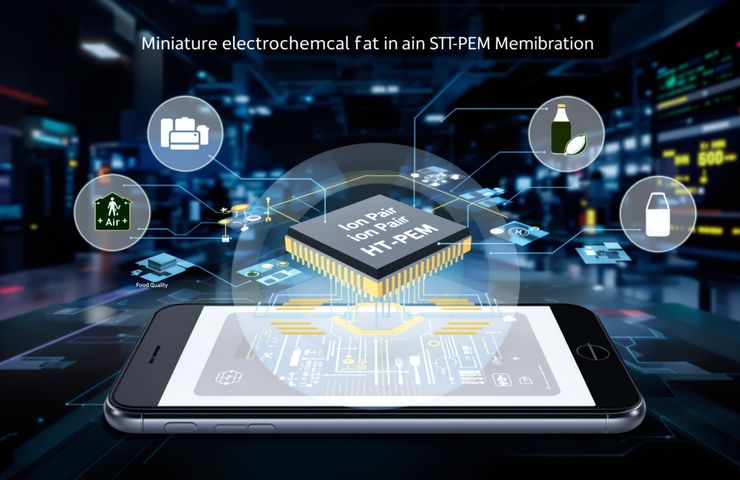
Fuel Cell Technology Fuels Next-Gen Electrochemical Gas Sensors
August 25, 2025Picture this: your smartphone diagnosing early-stage cancer by simply analyzing your breath. It sounds like sci-fi, right? Well, that moment is inching closer. On August 21, 2025, Advent Technologies Holdings, Inc.—the trailblazer in high-temperature proton exchange membrane (HT-PEM) innovation—teamed up with a leading U.S.-based global semiconductor and wireless technology player. Their goal? Co-develop and test next-gen electrochemical gas sensors built around Advent’s exclusive Ion Pair membrane.
Why This Partnership matters
This collaboration isn’t just about beefing up fuel cell technology for big power stations. Instead, it’s about shrinking that tech down into pocket-sized sensors for air quality checks, food-safety scans, and even non-invasive medical diagnostics—imagine bedside screening for biomarkers or breath-based early cancer detection. And we’re not talking bulky lab gear. These sensors could slot right into portable electronics like smartphones, wearables, or smart-home gadgets.
Getting to Know the Ion Pair Membrane
At the heart of this project is Advent’s HT-PEM Ion Pair membrane, originally cooked up at Los Alamos National Laboratory. Here’s what makes it tick:
- High-Temperature Stability: Keeps its cool (or heat) at elevated temperatures, boosting sensitivity and warding off contamination.
- Mechanical Robustness: Handles the stresses of microfabrication like a champ, paving the way for wafer-scale integration.
- Proton Conductivity: Powers precise electrochemical reactions, turning gas concentrations into clear electrical signals.
In practice, trace gases—whether from air, breath, or food aromas—interact with tiny catalyst sites in the membrane. Protons zip through the structure, generating a current that directly corresponds to gas levels. It’s essentially the same principle behind hydrogen fuel cells, just miniaturized to detect parts-per-billion of target molecules.
The Market Is Ripe for Tiny Powerhouses
We’re living in an era where remote monitoring, telemedicine, and the Internet of Things are converging. Demand for compact, low-power sensors is skyrocketing across industries. In an industrial setting, they’ll be vital for leak detection in hydrogen infrastructure—critical as pipelines and refueling stations lean on real-time safety monitoring. Meanwhile, restaurants, breweries, and food distributors need on-site gas analysis to keep products fresh. And consumers? They’re craving smarter air-quality tracking, whether they’re at home or on the move.
How This Stacks Up Against Other Sensors
Sure, metal oxide semiconductor and MEMS-based sensors have made strides, but they often demand high operating temperatures or struggle with specificity. Advent’s Ion Pair HT-PEM approach offers a sweet spot: pinpoint selectivity at moderate power levels, plus a direct electronic readout that jives perfectly with digital electronics.
Impact on Society and the Environment
Embedding accurate gas sensors into everyday devices democratizes environmental monitoring. Imagine crowdsourced air-quality maps updated in real time by the phones in people’s pockets—no more wondering if that smog alert really applies to your street. Restaurants could scan spoilage gases at the pallet before it even reaches the shelves, slashing waste. Hospitals could breeze through breath-marker screenings for early disease detection, easing the load on lab facilities and cutting costs.
Business and Strategy Moves
What’s in it for the two partners? For Advent, it’s about broadening its patent fortress—around 150 issued or pending patents—and tapping into global semiconductor know-how. For the unnamed tech giant, it’s a chance to weave advanced sensor miniaturization into its chip roadmap, fast-tracking its entry into healthtech and environmental-monitoring markets.
Both parties stand to gain from:
- Market Expansion: From city-wide air-monitoring networks to food-processing plants hungry for precise gas profiling.
- Healthtech Innovation: Telemedicine and point-of-care diagnostics are crying out for non-invasive, cost-effective screening tools.
- Consumer Electronics: Smartwatches, earbuds, and phones could boast a brand-new feature—molecular sensing on the go.
Plus, this partnership could open licensing doors, as other device makers prefer adopting proven membrane materials rather than building them from scratch.
Sizing Up the Competition
Big names like Bosch and Sony have rolled out MEMS-based gas sensors, but they often juggle power consumption and specificity. Advent’s Ion Pair platform could hit a unique sweet spot with robust performance at moderate temperatures, stellar selectivity, and seamless integration with the partner’s advanced wireless modules. Nail the cost curve, and these tiny sensors could shake up a market long dominated by bulky, less flexible modules.
Livermore: Where Science Meets Startup Vibe
Advent’s HQ in Livermore, California, sits smack in the innovation corridor that gave us Lawrence Livermore National Lab. With about 87,000 residents and a per-capita rent of $2,324, Livermore has transformed from a science outpost into a buzzing hub where material science collides with microelectronics and startup energy.
Overcoming the Hurdles Ahead
Miniaturizing cutting-edge tech is never a cakewalk. The teams will need to:
- Prove long-term durability under repeated cycling
- Stamp out cross-sensitivity between different gases
- Merge the membranes with existing chip-fabrication workflows
- Perfect device packaging and power management to hit consumer-price targets in the cutthroat smartphone market
Looking Out to the Horizon
In the coming months, lab tests will put the Ion Pair sensors through their paces—checking sensitivity, selectivity, and endurance. If all goes well, prototype devices could pop up by late 2026, with small-batch production kicking off in 2027 and a full-blown commercial rollout by 2028. Beyond smartphones, these membranes might find homes in industrial automation systems, drone-based environmental mapping services, or futuristic fitness wearables that track metabolic biomarkers during workouts.
It’s a clear sign that decades of R&D in hydrogen fuel cells aren’t just confined to vehicles. Membranes, catalysts, and stack designs fine-tuned for heavy-duty transport are now getting a second wind in sensor tech. That kind of cross-pollination is exactly what sparks major leaps in innovation.
Ultimately, this pact underscores a broader shift: as we build out sustainable energy systems and push for industrial decarbonization, supporting technologies like gas sensors become indispensable. They ensure safety in hydrogen infrastructure, boost public health through better air-quality monitoring, and open doors to new consumer experiences that weave zero-emission tech into everyday life.
The Catalyst will be keeping a close eye on how these micro-sensors evolve—from Livermore lab benches to the devices in your pocket—and what breakthroughs lie around the corner.
About Advent Technologies Holdings, Inc.Headquartered in the U.S. with major operations in Greece, Advent sits at the cutting edge of HT-PEM fuel cell technology, backed by about 150 patents. Born out of Los Alamos National Laboratory, the company trades on NASDAQ under the ticker ADN.



 With over 15 years of reporting hydrogen news, we are your premier source for the latest updates and insights in hydrogen and renewable energy.
With over 15 years of reporting hydrogen news, we are your premier source for the latest updates and insights in hydrogen and renewable energy.